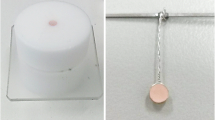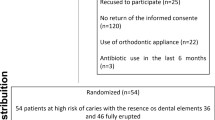Abstract
Aim
The aim of this study was to provide preliminary data on the most effective erythrosine concentration and light dose for the erythrosine-based photodynamic therapy (PDT) of oral plaque biofilms formed in vivo.
Method
A randomised controlled study with 15 volunteers was carried out to investigate the effect of photosensitiser and light dose on the killing of bacteria in oral plaque biofilms formed in vivo. All volunteers wore a removable in situ appliance carrying six enamel slabs for two phases of 2 weeks each. During this time, plaque biofilms accumulated on the enamel slabs. The slabs were then removed from the appliances for PDT treatment in vitro. In the first phase of the study, erythrosine doses of 22 and 220 μM were used for the photodynamic treatment of the biofilms. In the second phase, the erythrosine concentration was kept constant, and the light dose was varied. Following treatment, the biofilms were disaggregated, and the total bacterial killing was determined using colony counting.
Results
The erythrosine dose of 220 μM caused the most cell killing relative to controls. Fifteen minutes of continuous irradiation with light and light fractionation of 5 × 1 min irradiation separated by 2-min-dark recovery periods were found to be the most effective bactericidal regimes.
Conclusion
Erythrosine-based PDT shows promise as an antibacterial treatment for oral plaque biofilms. Further research is needed to prove its clinical and cost-effectiveness compared with current best practice.




Similar content being viewed by others
References
Allaker RP, Douglas CWI. Novel anitimicrobial therapies for dental plaque related diseases. Int J Antimicrob Agents. 2009;33:8–13.
Berney M, Hammes F, Bosshard F, Weilenmann HU, Egli T. Assessment and interpretation of bacterial viability by using the live/dead baclight kit in combination with flow cytometry. Appl Environ Microbiol. 2007;73:3283–90.
Cury AA, Tabchoury CPM. In situ study of sucrose exposure, mutans Streptococci in dental plaque and dental caries. Braz Dent J. 2001;12(2):101–4.
Dige I, Nilsson H, Kilian M, Nyvad B. In situe identification of streptococci and other bacteria in intial dental biofilm by confocal laser scanning microscopy and fluorescence in situ hybridization. Eur J Oral Sci. 2007;115:459–67.
Embleton ML, Nair SP, Cookson BD, Wilson M. Selective lethal photosensitisation of methicillin-resistant Staphylococcus aureus using an IgG-tin (IV) chlorine e6 conjugate. J Antimicrob Chemother. 2002;50:857–64.
Ganesan L, Margolles-Clark E, Song Y, Buchwald P. The food colorant erythrosine is a promiscuous protein-protein interaction inhibitor. Biochem Pharmacol. 2011;81:810–8.
Goulart Rde C, Thedei G, Souze SL, Tedesco AC, Ciancaglini P. Comparative study of methylene blue and erythrosine dyes employed in photodynamic therapy for inactivation of planktonic and biofilm-cultivated aggregatibacter actinomycetemcomitans. Photomed Laser Surg. 2010;28:85–90.
Konan YN, Gurny R, Alleman E. State of the art in the delivery of photosensitisers for photodynamic therapy. J Photochem Photobiol B. 2002;66:89–106.
Konopka K, Goslinski T. Photodynamic therapy in dentistry. J Dent Res. 2007;86:694–708.
Kumar PS, Griffen AL, Moeschberger ML, Leys EJ. Identification of candidate periodontal pathogens and beneficial species by quantitative 16S clonal analysis. J Clin Microb. 2005;43:3944–55.
Lethinen J, Nuutila J, Lilius EM. Green fluorescent protein-propidium iodide (GFP-PI) based assay for flow cytometric measurement of bacterial viability. Cytom A. 2004;60:165–72.
Marsh PD. Dental plaque as a microbial biofilm. Caries Res. 2004;8:263–71.
Meisel P, Kocher T. Photodynamic therapy for periodontal diseases. State of the art. J Photochem Photobiol B. 2005;79:159–70.
Metcalf D, Robinson C, Devine D, Wood S. Enhancement of erythrosine-mediated photodynamic therapy of Streptococcus mutans biofilms by light fractionation. J Antimicrob Chemother. 2006;58:190–2.
Moor ACE, Ortel B, Hasan T. Mechanisms of photodynamic therapy; In: Patrice T, editor. Photodynamic Therapy-Comprehensive series in photochemistry and photobiology. Royal Society of Chemistry; 2003, pp 21–44.
Patterson MS, Wilson BC, Graff R. In vivo tests of the concept of photodynamic threshold dose in normal rat liver photosensitized by aluminium chlorosulphonated phthalocyanine. Photochem Photobiol. 1990;51:343–9.
Socransky SS, Smith C, Haffajee AD. Subgingival microbial profiles in refractory periodontal disease. J Clin Periodontol. 2002;29:260–8.
Sreenivasan P, Gaffar A. Antiplaque biocides and bacterial resistance: a review. J Clin Periodontol. 2002;29:965–74.
Wood S, Metcalf D, Devine D, Robinson C. Erythrosine is a potential photosensitizer for the photodynamic therapy of oral plaque biofilms. J Antimicrob Chemother. 2006;57:680–4.
Acknowledgments
The authors are grateful to Dr R. Percival for training in microbiological techniques and Mrs T. Munyombwe for the statistical analysis component of this study.
Conflict of interest
The authors declare no conflict of interest. The authors alone are responsible for the content and writing of the paper.
Author information
Authors and Affiliations
Corresponding author
Rights and permissions
About this article
Cite this article
Tahmassebi, J.F., Drogkari, E. & Wood, S.R. A study of the control of oral plaque biofilms via antibacterial photodynamic therapy. Eur Arch Paediatr Dent 16, 433–440 (2015). https://doi.org/10.1007/s40368-014-0165-5
Received:
Accepted:
Published:
Issue Date:
DOI: https://doi.org/10.1007/s40368-014-0165-5




